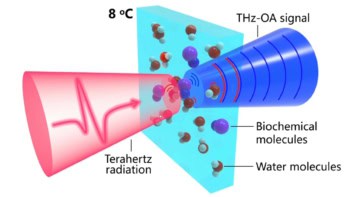
Verification of radiation dose at the time of radiotherapy is a necessity to ensure accurate dose delivery to a malignant tumour. With many radiation treatments, daily verification is performed using a series of technologies that give partial information, such as optical surface positioning, electronic portal dosimetry or cone-beam CT position evaluation. But the process requires a series of tools and involves substantial data analysis. Cherenkov imaging offers the potential for automated, non-contact verification of the beam position on the patient’s body, imaged in real-time as the patient is receiving treatment.
Researchers at the Thayer School of Engineering at Dartmouth College have been investigating Cherenkov imaging for use in external-beam radiotherapy for three years. This novel optical imaging technique enables visualization of the radiation dose delivery into tissue. In 2014, the team reported its use in monitoring real-time changes in the delivery of fractionated radiation beams to the patient’s tissue, during a study of 12 cancer patients (see Cerenkoscopy monitors breast treatments).
The research team has now developed a Cherenkov image processing algorithm that maximizes accurate recovery of beam edges. The algorithm enables quantification of daily variations of intrafraction treatment. This capability is a step closer to automating analysis of this imaging approach, and facilitating its development as a commercial radiotherapy verification tool (J. Med. Imaging 5 015001).
Because Cherenkov images are inherently noisy, with signal quality affected by factors such as the lighting conditions in the radiotherapy treatment suite and the camera acquisition parameters, image processing is needed to maximize accurate recovery of beam edges. Principal investigator Brian Pogue and colleagues examined methods to quantify the beam edges and tested the quantification approaches with both phantom and patient data.
The team acquired images from seven breast cancer patients undergoing radiotherapy in up to nine treatment sessions. They then imaged five treatment plans with varying levels of beam modulation delivered to a breast phantom. These images were used to create a calibration set of quantitatively known values for comparison with day-to-day variations of patient images. For each plan, the phantom was imaged after being moved by 1.0, 3.0 and 5.0 mm from its original position in the anteroposterior (AP) direction.
The researchers analysed treatment dose at three control points for each patient. Video data were temporarily integrated into a single, composite summary image at each control point. They used three different edge-preserving filtering methods to reduce noise. A series of image processing functions were bundled together to enforce edge preservation in segmenting the images, to outline the Cherenkov field of where the beam was incident.
The authors used Dice coefficients and mean distance to conformity values for analysis and comparison of day-to-day variation. They determined that the patient data could be compared with the calibrated breast phantom data, such that the patient variations could be estimated by known systematic shifts of the phantom image data.
They also found that the patient data had slightly more variation than the absolute 3 mm phantom position shift, indicating that daily variation was greater than expected, based upon positioning goals. The authors suggested that this occurred because of the complexity of day-to-day positioning of the patients.
The Dartmouth team will conduct further tests using their processing algorithm to analyse the variations seen in patients receiving whole-breast radiotherapy, to assess day-to-day variations in beam delivery as a quality audit system for patient position and beam variation.



